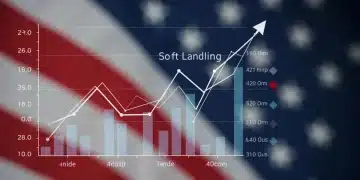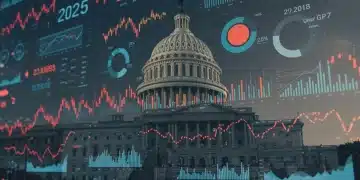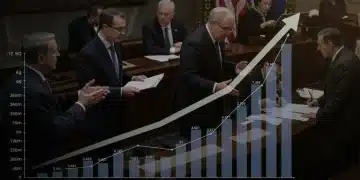Expert Forecast: Will US Economy Face Recession in 12 Months?
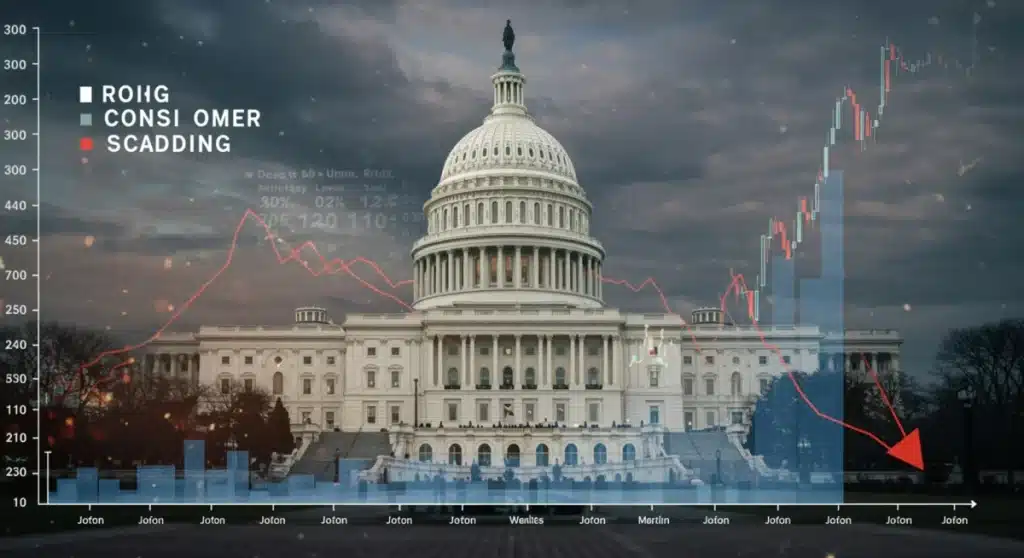
Experts are closely monitoring various economic indicators to determine the probability of the US economy entering a recession within the next 12 months, with opinions diverging based on the interpretation of current trends and historical patterns.
The question on everyone’s mind, from Main Street to Wall Street, is a critical one: Expert Forecast: Will the US Economy Enter a Recession in the Next 12 Months? This isn’t just an academic debate; it directly impacts investment decisions, career planning, and household budgets across the nation. Understanding the nuanced perspectives of leading economists and financial institutions is crucial for navigating these uncertain times.
Understanding the Current Economic Landscape
Before diving into forecasts, it’s essential to grasp the current state of the US economy. We’ve witnessed a period of robust growth post-pandemic, fueled by significant fiscal stimulus and accommodative monetary policy. However, this growth has come with its own set of challenges, primarily persistent inflation and the Federal Reserve’s aggressive response.
The economy is currently characterized by a resilient labor market, with unemployment rates remaining historically low. Consumer spending, while showing some signs of moderation, has largely held up. Business investment, however, presents a more mixed picture, with some sectors experiencing slowdowns due to higher borrowing costs and global uncertainties.
Key Economic Indicators to Watch
Several indicators serve as critical barometers for economic health. Monitoring these can provide early signals of a potential downturn or continued stability.
- Inflation Rates: The pace at which prices for goods and services are rising. High, persistent inflation erodes purchasing power and can lead to reduced consumer spending.
- Interest Rates: Set by the Federal Reserve, these influence borrowing costs for consumers and businesses. Higher rates can cool down an overheating economy but also risk stifling growth.
- GDP Growth: The total value of goods and services produced in the country. Consecutive quarters of negative GDP growth are a common definition of a recession.
- Unemployment Rate: A key measure of labor market health. A significant rise often accompanies economic downturns.
The interplay of these factors creates a complex economic environment, making accurate predictions challenging. Each indicator offers a piece of the puzzle, and economists must synthesize this information to form a comprehensive outlook.
The Federal Reserve’s Role and Monetary Policy
The Federal Reserve stands at the forefront of managing the US economy, wielding significant influence through its monetary policy decisions. Their primary mandate is to achieve maximum employment and stable prices, which currently translates to combating inflation without triggering a severe recession.
Over the past year, the Fed has embarked on a series of aggressive interest rate hikes, aiming to cool demand and bring inflation back down to its target of 2%. This strategy, known as monetary tightening, is a delicate balancing act. Raise rates too much, and the economy could tip into recession; not enough, and inflation could become entrenched.
Impact of Interest Rate Hikes
Higher interest rates ripple through the economy in several ways:
- Increased Borrowing Costs: Loans for homes, cars, and businesses become more expensive, potentially slowing down investment and consumer purchases.
- Reduced Consumer Spending: As disposable income is allocated to higher debt payments, less is available for other goods and services.
- Cooling Housing Market: Mortgage rates rise, making homeownership less affordable and slowing down construction activity.
- Strengthening Dollar: Higher US interest rates can attract foreign investment, strengthening the dollar, which makes US exports more expensive.
The market is constantly scrutinizing Fed communications for clues about future policy moves. Any hint of a pause or pivot in rate hikes can significantly impact investor sentiment and economic expectations. The challenge for the Fed is to communicate clearly while maintaining flexibility in response to evolving economic data.
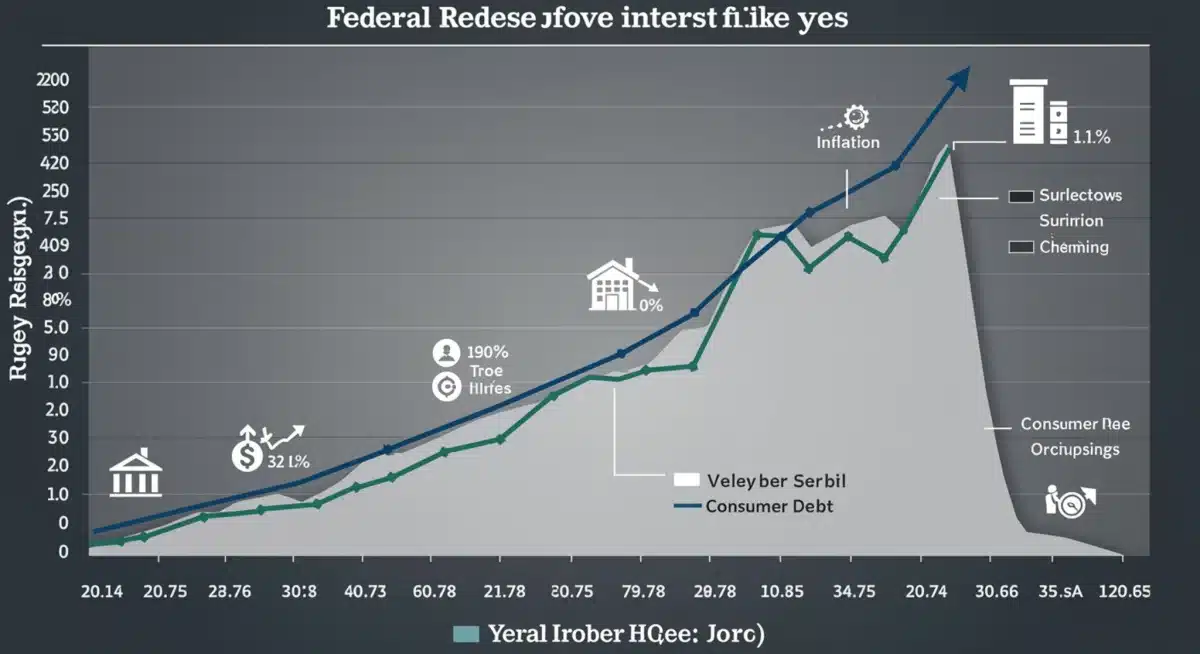
Inflation: The Persistent Challenge
Inflation has been a dominant theme in the US economy for the past couple of years, reaching levels not seen in decades. While it has shown signs of moderating, particularly in certain sectors, it remains elevated above the Fed’s target.
The causes of this inflation are multifaceted, stemming from supply chain disruptions during the pandemic, robust consumer demand fueled by stimulus, and geopolitical events impacting energy and food prices. Wage growth, while beneficial for workers, has also contributed to inflationary pressures as businesses pass on higher labor costs to consumers.
Understanding Inflationary Pressures
Several factors continue to fuel inflation:
- Supply Chain Resilience: Although improving, some supply chain bottlenecks persist, impacting the availability and cost of certain goods.
- Energy Prices: Global events and production decisions can lead to price spikes, impacting businesses and consumers worldwide.
- Wage-Price Spiral Concerns: The fear that rising wages lead to higher prices, which in turn lead to demands for even higher wages, creating a self-perpetuating cycle.
- Housing Costs: Rents and housing prices have remained sticky, representing a significant portion of consumer budgets and contributing to core inflation.
Controlling inflation is paramount for long-term economic stability. If inflation remains stubbornly high, it could necessitate further aggressive action from the Fed, increasing the risk of an economic downturn. The path of inflation will be a key determinant of whether the US economy can avoid a recession.
Labor Market Resilience vs. Economic Slowdown
One of the most perplexing aspects of the current economic climate is the surprising resilience of the US labor market. Despite aggressive interest rate hikes and widespread concerns about a looming recession, job growth has remained strong, and unemployment rates have stayed near historic lows.
This strength in the labor market is a significant buffer against a severe downturn. A robust job market means consumers generally have income to spend, which helps to sustain demand. However, there are also signs that the labor market might be starting to cool, with some sectors experiencing hiring freezes or layoffs, particularly in technology.
Signs of Cooling in the Labor Market
While overall numbers remain positive, economists are closely watching for subtle shifts:
- Job Openings: The number of available jobs has decreased from its peak, suggesting a rebalancing between labor supply and demand.
- Wage Growth Moderation: While still elevated, the pace of wage increases is showing signs of slowing down, which could help ease inflationary pressures.
- Unemployment Claims: Initial jobless claims, though still low, have seen minor fluctuations, warranting careful observation.
- Sectoral Disparities: Some industries, like hospitality and healthcare, continue to struggle with labor shortages, while others, like tech, are seeing increased layoffs.
The Federal Reserve hopes for a ‘soft landing’ where the labor market gradually cools without a significant rise in unemployment. This would involve a reduction in job openings and a more balanced supply-demand dynamic, rather than widespread job losses. The ability to achieve this soft landing will be crucial in avoiding a recession.
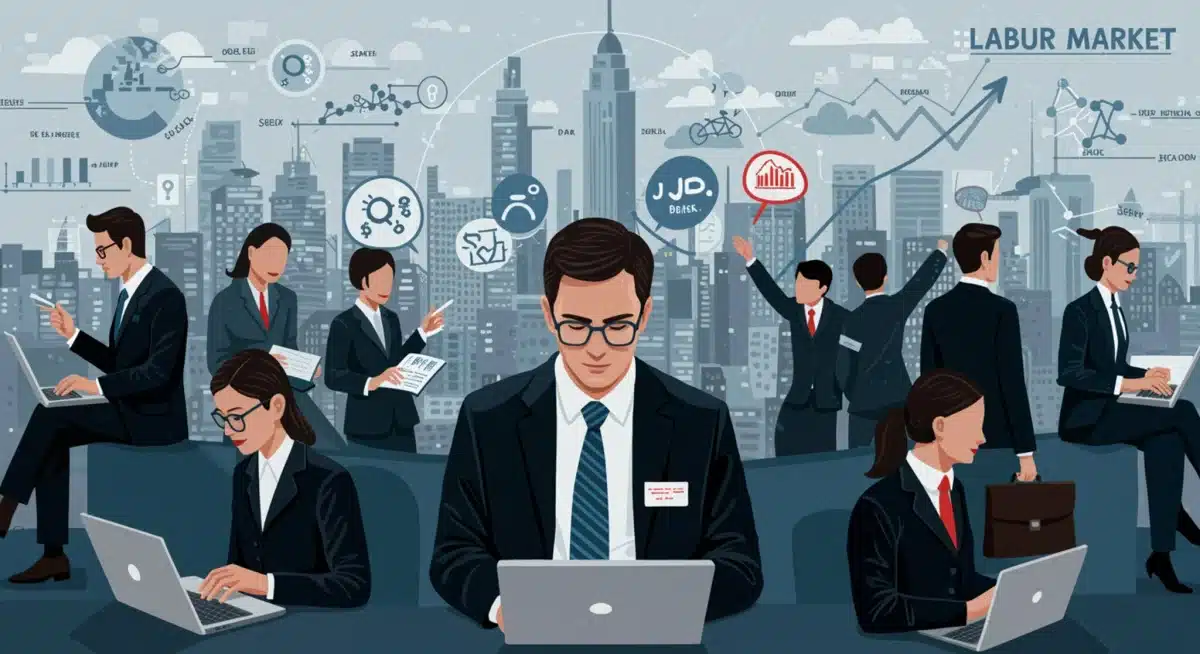
Consumer Behavior and Business Investment
Consumer spending accounts for a significant portion of US GDP, making it a critical driver of economic activity. Despite inflationary pressures, consumers have largely maintained their spending habits, supported by strong employment and accumulated savings from the pandemic era. However, there are growing concerns about the depletion of these savings and the increasing reliance on credit.
Business investment, on the other hand, tends to be more sensitive to economic uncertainty and higher interest rates. Companies may delay expansion plans or reduce capital expenditures when the outlook is unclear, which can further slow economic growth.
Factors Influencing Consumer and Business Decisions
The decisions made by consumers and businesses are shaped by a variety of influences:
- Consumer Confidence: Sentiment about future economic conditions can significantly impact spending and saving patterns.
- Household Debt Levels: Rising debt, especially credit card debt, can constrain future spending capacity.
- Corporate Earnings: Strong earnings encourage investment, while declining profits can lead to cost-cutting measures.
- Access to Credit: Higher interest rates and tighter lending standards can make it more difficult for businesses to secure financing for growth.
A sustained slowdown in consumer spending or a sharp decline in business investment would significantly increase the probability of a recession. Policymakers are keenly aware of these dynamics and are looking for signs of weakening demand that could signal a broader economic contraction.
Geopolitical Factors and Global Economic Headwinds
The US economy does not operate in isolation. Geopolitical events and the health of the global economy play a substantial role in shaping domestic economic prospects. Conflicts, trade disputes, and economic slowdowns in major trading partners can have ripple effects that impact US growth, inflation, and financial markets.
The ongoing conflict in Eastern Europe, for instance, has contributed to volatility in energy and commodity markets, exacerbating inflationary pressures. Economic slowdowns in China and Europe could reduce demand for US exports and disrupt global supply chains, further complicating the economic outlook.
External Risks to the US Economy
Several external factors could influence the US economic trajectory:
- Global Inflation: Inflationary pressures in other major economies can feed into US import costs and global supply chains.
- Energy Market Volatility: Disruptions to global energy supplies can lead to price spikes, impacting businesses and consumers worldwide.
- Trade Tensions: Escalating trade disputes or protectionist policies can harm global trade and economic growth.
- International Capital Flows: Shifts in global investment patterns can affect the strength of the US dollar and domestic financial conditions.
These external factors add another layer of complexity to forecasting the US economy. While the US economy is relatively resilient, a severe global downturn or a major geopolitical shock could significantly alter the domestic economic landscape, making a recession more likely regardless of internal conditions.
Expert Consensus and Divergent Views
When it comes to the question of whether the US economy recession is imminent, there is no single, unanimous answer among experts. Forecasts range from a high probability of a mild recession to a belief in a ‘soft landing’ or even continued growth.
Those who foresee a recession often point to the aggressive interest rate hikes, the inverted yield curve (a historical recession predictor), and the potential for consumer spending to finally buckle under the weight of inflation and debt. They argue that the lagged effects of monetary policy will inevitably lead to a contraction.
Arguments for a Recession
Economists forecasting a recession often highlight:
- Inverted Yield Curve: Historically, this has been a reliable predictor of future recessions, indicating bond investors anticipate slower growth.
- Tightening Credit Conditions: Banks are becoming more cautious in lending, which can restrict economic activity.
- Lagged Effects of Monetary Policy: The full impact of interest rate hikes takes time to materialize, suggesting more economic slowdown is yet to come.
- Depleting Household Savings: Pandemic-era savings are running out, potentially reducing consumer resilience.
Conversely, those who predict a soft landing or no recession emphasize the strength of the labor market, the resilience of consumer spending thus far, and the potential for inflation to continue moderating without a severe economic contraction. They believe the Fed may successfully navigate the economy to a more stable state.
Arguments Against a Recession (Soft Landing)
Proponents of a soft landing or continued growth often cite:
- Strong Labor Market: Continued job growth and low unemployment provide a solid foundation for consumer demand.
- Resilient Consumer Balance Sheets: Despite some depletion, overall household finances remain relatively healthy for many.
- Corporate Adaptability: Businesses have shown flexibility in adjusting to changing economic conditions.
- Disinflationary Trends: Inflation is slowly coming down, potentially allowing the Fed to ease its tightening stance.
The divergence in expert opinion underscores the inherent uncertainty in economic forecasting. Each perspective offers valuable insights, but the ultimate outcome will depend on how various economic forces interact and how policymakers respond to new data.
| Key Economic Factor | Current Outlook |
|---|---|
| Inflation | Elevated but moderating; still above Fed’s 2% target. |
| Interest Rates | Significantly raised by Fed; impact still unfolding. |
| Labor Market | Strong and resilient, though showing signs of cooling. |
| Consumer Spending | Holding up, but concerns about savings depletion rising. |
Frequently Asked Questions About the US Economic Outlook
An inverted yield curve occurs when short-term government bonds yield more than long-term ones. Historically, this unusual pattern often signals that investors expect slower economic growth or a recession in the future, prompting them to demand higher returns for short-term commitments.
The Federal Reserve primarily controls inflation by adjusting the federal funds rate, which influences borrowing costs across the economy. Raising rates makes borrowing more expensive, thereby reducing demand for goods and services, cooling the economy, and ultimately curbing price increases.
A “soft landing” refers to a scenario where the central bank successfully tightens monetary policy to bring down inflation without causing a significant economic downturn or recession. It’s a delicate balancing act where economic growth slows but avoids a contraction.
A global economic slowdown can impact the US economy through reduced demand for American exports, disruptions in global supply chains, and decreased international investment. These factors can collectively hinder US economic growth and contribute to domestic uncertainties.
While consumer savings accumulated during the pandemic provided a significant buffer, many analysts believe these reserves are largely depleted for a substantial portion of households. Continued reliance on credit could indicate weakening financial positions, potentially increasing recession risks if incomes don’t keep pace.
Conclusion
The question of whether the US economy will enter a recession in the next 12 months remains a complex and evolving one. While significant headwinds like persistent inflation, aggressive interest rate hikes, and global uncertainties present considerable risks, the underlying strength of the labor market and, to some extent, consumer spending, offer a degree of resilience. Experts remain divided, reflecting the delicate balance of forces at play. Monitoring key economic indicators and understanding the Federal Reserve’s policy trajectory will be essential for individuals and businesses to prepare for potential shifts in the economic landscape. The path ahead is uncertain, but a thorough understanding of these dynamics is the first step toward informed decision-making.
